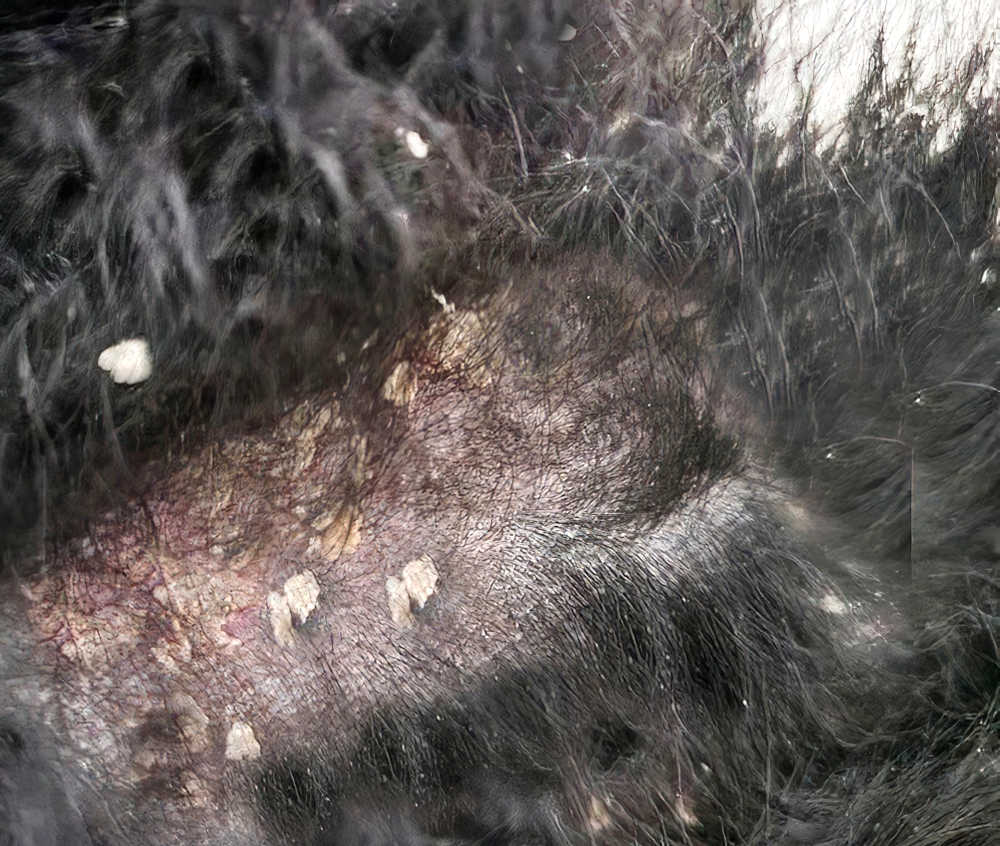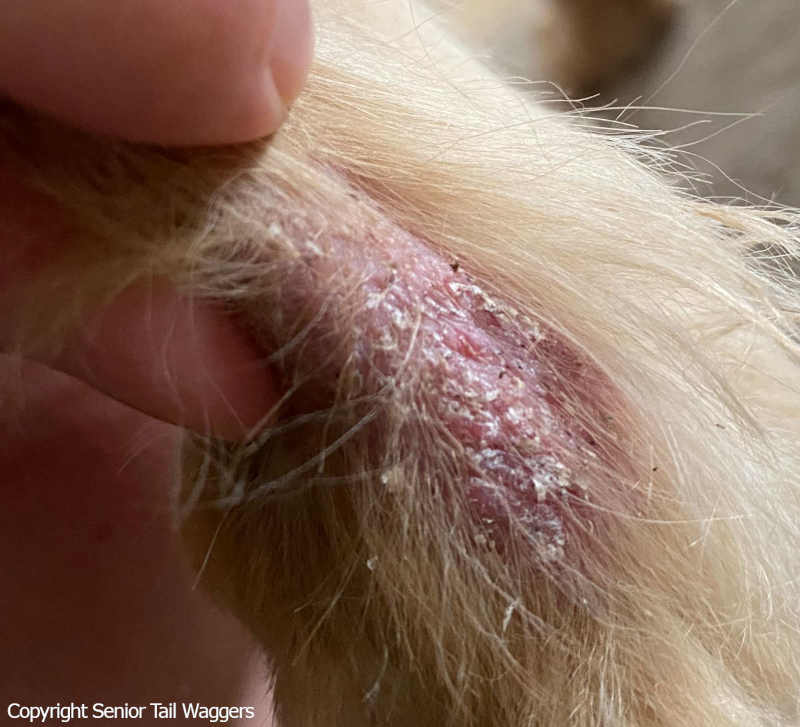
This article was updated on January 24th, 2024
Dogs can develop dandruff, which can cause their once-glossy coat to become oily, dry, smelly, flaky, or red. However, dandruff is usually a symptom and not a disease itself. In this article, we’ll discuss what dandruff looks like, what causes it, and how to treat it.
What dandruff looks like in dogs [with pictures]
Dandruff in dogs typically appears as flaky, white or grayish scales on the skin, often accompanied by itching and possibly redness or irritation. Dandruff is dead skin cells that have fallen off the skin and may be stuck in your dog’s coat.
Some dogs may experience flaky skin, but this is not always a cause for concern
The picture below shows a mild case of dandruff. In mild cases, consistent grooming and skin supplements may be enough to alleviate the issue.

Dandruff is a cause for concern when accompanied by other signs such as greasy skin, itchiness, hair loss or a bad smell
Below is a close-up picture of a dog coat showing moderate dandruff, flakes, hair loss, and mild skin redness.

Dandruff is usually most noticeable on the face, flank, and back. Dandruff may be associated with a foul odor as the skin condition deteriorates. This odor often means your dog also has a bacterial or yeast infection on the skin as well.
Dogs can have wet (oily) or dry seborrhea
Dandruff can be oily or dry and may have very different appearances depending on the underlying cause. Your veterinarian may refer to the condition as seborrhea, a condition of overactive sebaceous glands in the skin that results in too much sebum or skin oils.
There are two types of seborrhea, and your dog may have a combination of the two.
- Dry dandruff, or seborrhea sicca, usually consists of flakes and a dull coat.
- Oily dandruff, or seborrhea oleosa, tends to give the dog’s coat a wet, oily appearance and often has a foul odor.

Below is a close-up picture of a small dog with oily seborrhea. The coat is not shiny and vibrant, but is dull and has a slick oily appearance.

What causes dog dandruff?
Dandruff in dogs is often just a symptom and identifying the root cause can lead to the right treatment. Common causes include:
1. Allergies: The skin is one of your dog’s natural barriers to infection. When a dog suffers from allergies (food or environmental), the skin is weakened and damaged by chronic itching, scratching, and inflammation. You may notice your dog scratching all over his body or licking his paws excessively along with dandruff. Dogs with allergies are also more prone to recurring ear infections.

2. Skin infections: Bacterial and yeast infections on the skin can contribute to flakiness. They disrupt normal skin bacteria and cause inflammation, redness, and dandruff.



3. Genetics: Some breeds have a genetic mutation that predisposes them to a condition called ichthyosis. With this condition, the outer layer of skin doesn’t develop properly, and the dog has chronic dandruff. Ichthyosis is an inherited recessive trait, meaning your dog would have to get a copy of the gene mutation from both mother and father.
If they only receive a copy of the gene from one parent, they will not be affected by genetic dandruff. A genetic test for this mutation costs between $50-100. Affected breeds include some Golden retrievers, Cavalier King Charles spaniels, and Yorkshire terriers.
4. Poor Diet: Most commercial dog foods offer a balanced diet for your dog’s life stage. Poor diets may not have the needed vitamins or fatty acids to maintain healthy skin. Dogs with digestive or absorption issues may also have dull or flaky coats since they cannot utilize or absorb nutrients appropriately.
5. Hygiene: Irregular grooming may contribute to your dog’s dandruff. When our pets aren’t routinely bathed and brushed, the hair and oils are not distributed and can cause oiliness and flakes.
6. Systemic Diseases: Certain metabolic and hormone imbalances can significantly impact your dog’s coat. Hypothyroidism and Cushing’s disease are very common culprits. Many owners find that the skin quickly improves once they start treating their hypothyroid or Cushingoid dog.
7. Dry Weather: Just like our skin dries out in colder and drier weather, your dog’s skin can also.
Three steps you can take at home to help your dog
1. Humidifier: If you notice your dog’s dandruff is worse in the winter months, it may be due to cold, dry weather. A humidifier in the home can add moisture back into the air. Remember not to use any essential oils in the humidifier since some oils are toxic to dogs and cats.
2. Balanced Diet: A healthy balanced diet is a critical component for healthy skin in people and pets. While most commercial dog foods have omega fatty acids, some dogs benefit from supplementation.
Consider adding supplements with omega-3 and omega-6 fatty acids. Make sure to talk to your vet first – some formulations may be better than others since dogs process and metabolize fatty acids slightly differently than humans. Some research has shown that omega-3 fatty acids also have anti-inflammatory effects; supplementation may be an added benefit for dogs with dandruff due to allergies.
3. Hygiene and Grooming: Whether you take your dog to a groomer or do it yourself, routine bathing and grooming can help eliminate dandruff and promote a healthy, shiny coat. Brushing your dog’s coat can redistribute the skin’s natural oils.
When to call your veterinarian
Very mild cases of dandruff can typically be treated at home with gentle moisturizing shampoos and regular brushing and grooming. However, you should call your veterinarian if you notice:
- Extreme itchiness, pain, or discomfort
- Odor or redness associated with flaky skin
Veterinarian diagnosis and treatment for dog dandruff
Ultimately, your dog will have the best chance of getting rid of the flakes if your vet can determine why they are happening in the first place. Since dandruff is a symptom of many conditions, this can sometimes be a lengthy process.
There are a few tests your vet may want to run to rule out some common causes of dandruff:
- Skin scrape: The vet uses a small blade to scrape the superficial skin layers and looks at the sample under the microscope. They are looking for certain parasites like Demodex mites.
- Tape or slide cytology impressions: A microscope slide or tape is pressed against the affected skin (often where there is oozing or discharge). The slide is then dyed with a special dye and looked at under the microscope for bacteria and yeast.
- Bloodwork or specific hormone tests: If your vet suspects a hormone imbalance, they may recommend bloodwork to assess thyroid and steroid levels.
Recommended products to help stop dandruff at home
Along with treating any medical conditions, your veterinarian may recommend specific products for you to use at home to manage or prevent dandruff on your dog.
One popular product is a keratolytic shampoo. These shampoos often contain sulfur or salicylic acid and work by increasing the amount of water the outer skin layers absorb. This results in a softening of the skin.
Other moisturizing shampoos include ingredients like colloidal oatmeal, aloe, and glycerin, which help restore skin moisture.
There is a range of products other than shampoos that can help including conditioners and mousses, including some that don’t require bathing.
Key Tip: Do not use human dandruff shampoos or apple cider vinegar on your dog unless directed by your veterinarian. These products can alter your dog’s skin’s pH (acidity) and make things worse.
Also, be sure to follow your veterinarian’s bathing instructions – bathing your dog too frequently can strip the skin of its healthy oils too.
A good dog brush can help with mild dandruff too. Some brushes have dual sides – one side is steel bristles that can help remove excess hair, and the other side is nylon bristles that help redistribute the natural oils and make the coat glossy.
Be patient: skin conditions can take weeks to months to start showing improvement and healing.
If a genetic mutation like ichthyosis is causing the condition, your dog will never be completely healed from the disease and will probably always have some dandruff. In these cases, managing dandruff is lifelong and would likely include a combination of therapies to maintain a healthy coat and skin.
If a hormone imbalance is a cause – like with hypothyroidism and Cushing’s disease – your dog’s health will rely on controlling that disease. Both conditions can seriously affect your dog’s skin, making them dull and flaky. Once these conditions are well-managed, the skin usually improves drastically.
Frequently asked questions
How do you get rid of dandruff on a dog?
Dandruff in dogs is quite common and is relatively easy to treat in most cases. Your dog can have a dandruff-free shiny coat again, but getting rid of the problem will depend on the underlying cause. If your dog has an allergy that may be contributing to dandruff formation, you may need to switch foods and clean their environment, toys, and bedding more frequently.
Many dogs require diet changes, humidifiers, hygiene and grooming, and topical shampoos. If your dog has red, itchy skin or worsening dandruff, you should schedule an appointment with your veterinarian. Skin issues require collaboration between pet owners and vets to diagnose and treat these skin conditions.
Are certain dog breeds more prone to dandruff?
While any breed can develop dandruff, certain breeds are more prone to seborrhea or other skin conditions that cause dandruff, including Westhighland White terriers, spaniels, dachshunds, and Golden retrievers.
Is my dog in pain because of dog dandruff?
Mild cases of dandruff typically do not bother a dog or cause pain. If the skin is red or itchy with pustules, there may be a bacterial or yeast infection. In these cases, your dog may be experiencing some intense itchiness and discomfort.
How common is dandruff in dogs?
Dandruff is a fairly common condition in dogs, but the key to managing it lies in finding the underlying cause if there is one. Treatment can then be targeted toward a specific reason, and your dog can have a healthy, flake-free coat again.
Disclaimer: This website's content is not a substitute for veterinary care. Always consult with your veterinarian for healthcare decisions. Read More.


My dog, Milky has been losing her hair coating for the last few days. I have noticed the fur on her bed and even on my arms when I carry her.
Do you think this is happening because of dandruff in her fur? Or could there be other reasons for it?
I want to help Milky have a healthy coat. Please, help guide me with this.